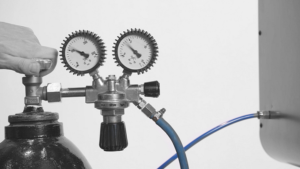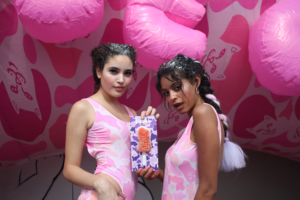 Two years ago, award-winning 3D artist Janne Kyttanen, the CEO of What The Future Venture Capital (WTFVC), launched a private beta version of his new food tech startup, Pixsweet, which sells all-natural, customizable ice pops that can be designed and 3D printed in just seconds. The 3D food customization platform and marketplace, which was also a test pilot for WTFVC’s 3D thermo injection (3DTi) technology, counts companies like Apple, Disney, Google, Instagram, Warner Brothers, Twitter, and several Minor League baseball teams as its launch customers.
Two years ago, award-winning 3D artist Janne Kyttanen, the CEO of What The Future Venture Capital (WTFVC), launched a private beta version of his new food tech startup, Pixsweet, which sells all-natural, customizable ice pops that can be designed and 3D printed in just seconds. The 3D food customization platform and marketplace, which was also a test pilot for WTFVC’s 3D thermo injection (3DTi) technology, counts companies like Apple, Disney, Google, Instagram, Warner Brothers, Twitter, and several Minor League baseball teams as its launch customers.
The sky’s the limit for its 3D printable ice pop mold designs – Pixsweet has created everything from logos and mascots to tasty emojis. The company also recently teamed up with industrial SLS 3D printer provider Sinterit to make ice pops for California-based clothing brand RipnDip.
Sinterit explained that 3DTi must be supported with 3D printing tools, and while Pixsweet initially used FDM technology, the startup soon recognized that it needed a more efficient way to 3D print ice pop molds, and turned to Sinterit’s desktop Lisa 2.
According to Pixsweet, “Scaling a business is always challenging but obviously an important factor when considering if your ‘idea’ has enough legs for the long run. Keeping the balance between your investments and understanding how secure your future really is, is an artform by itself.”
 Back in the early days of 3D printing, the only viable options for bringing ideas to life were outsourcing the 3D printing so you could create, test, validate, and verify your concepts before going all in with a 3D printer purchase, or spending a lot of money on your own costly industrial system first. But that isn’t the case anymore.
Back in the early days of 3D printing, the only viable options for bringing ideas to life were outsourcing the 3D printing so you could create, test, validate, and verify your concepts before going all in with a 3D printer purchase, or spending a lot of money on your own costly industrial system first. But that isn’t the case anymore.
Pixsweet was able to “capitalize on” Sinterit’s industrial-grade Lisa 2 to cost-effectively 3D print its custom ice pops on demand for just 10% of the normal investment it would have made. The SLS 3D printer can create detailed, precise parts without having to use any supports, and also uses a nitrogen chamber so it’s able to print with even more materials. The company provides industrial capabilities for hundreds of thousands of products in Pixsweet’s 3DTi production line without any wear and tear issues.
“SLS quality is perfect, there are no visible layers and the surface itself is very precise,” Kyttanen explained to Sinterit. “With Lisa we can also use only 30% of the material and re-use the other material again and again. That results in lowering the cost of single tool from 2,3$ to 1,5$ in material costs.”
While Pixsweet would have to spend €50 for a part at a regular 3D printing service bureau, the Lisa 2 helps lower this cost to just €21. Additionally, it can take service bureaus 5-7 days to complete a 3D printed part, but the Lisa 2 helps Pixsweet get its sweet products to market in just a day.
“When it comes to speed, quality and price, at the moment nothing else in the market compares to this,” Pixsweet wrote.
“The requirements for our tooling perfectly matches the Lisa 2 laser sintering machines. Our order processing is very dynamic. Somebody might come to us Thursday evening and want some custom 3D ice pops for a brand launch pool party the coming Saturday. The only way for us to have industrial level production on a 24-48h notice is to run nimble desktop laser sintering machines in house.”
 Recently, Pixsweet turned to the Sinterit Lisa 2 for a collaboration with RipnDip, which was founded by Ryan O’Connor in Orlando nine years ago. The clothing brand, now headquartered in Los Angeles, employs a very specific voice, and uses a lot of edgier designs on its products.
Recently, Pixsweet turned to the Sinterit Lisa 2 for a collaboration with RipnDip, which was founded by Ryan O’Connor in Orlando nine years ago. The clothing brand, now headquartered in Los Angeles, employs a very specific voice, and uses a lot of edgier designs on its products.
RipnDip turned to Pixsweet and its 3D printed ice pops for its Lick Me Till Ice Cream tour across the US, which is a rather unfortunate name in my opinion but matches the company’s vibe to a T.
The partnership used Sinterit’s SLS technology to create a totally customized experience for the tour, 3D printing ice pop molds featuring RipnDip’s signature branded cats (which are definitely flipping you the bird, in case you wondered), aliens, and logo by the thousands, while also creating custom sleeve packaging for its pop-up events.
Discuss this and other 3D printing topics at 3DPrintBoard.com or share your thoughts in the Facebook comments below.
[Images provided by Pixsweet]
Subscribe to Our Email Newsletter
Stay up-to-date on all the latest news from the 3D printing industry and receive information and offers from third party vendors.
You May Also Like
New Report: Semiconductor Industry to See $1.4B in 3D Printing Revenues by 2032
“The semiconductor sector has become the most strategically significant area of global industry.” Truer words are hard to come by when it comes to the modern world, and they are...
Will Photonic-Crystal Lasers Revolutionize 3D Printing?
Powder bed fusion (PBF) for metals and polymers predominantly utilizes lasers as the primary heat source. Some directed energy deposition (DED) technologies also employ lasers, while various vat polymerization methods...
3D Printing Unpeeled: Orbex Investment, IndoMIM and HP, Ultrasonic Waves
INDO-MIM has bought three HP Metal Jet S100 printers, operating two in India and one in Texas. This is a win for HP because the company has deep experience in...
3D Printing Webinar and Event Roundup: April 21, 2024
It’s another busy week of webinars and events, starting with Hannover Messe in Germany and continuing with Metalcasting Congress, Chinaplas, TechBlick’s Innovation Festival, and more. Stratasys continues its advanced training...



































